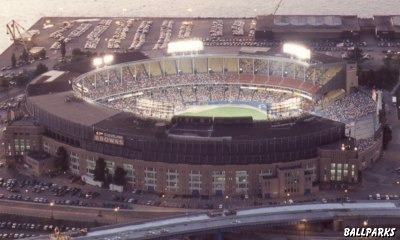Cleveland Municipal Stadium
Cleveland, OhioTenants: Cleveland Indians (AL); Cleveland Browns (NFL) Architect: F.R. Walker of Walker & Weeks Cleveland Indians tickets:
Location: On the shore of Lake Erie between the lake and downtown Cleveland. 1st base (S) W. 3rd and Cleveland Memorial Shoreway; 3rd base (W) Erieside Ave., Lake Erie and W. 3rd; left field (N)Erieside Ave. and Lake Erie; right field (E) Cleveland Memorial Shoreway. Dimensions: Foul lines: 322 (1932), 320 (1933), 319 (April 27, 1947), 320 (June 6, 1947), 321 (1948), 320 (1953); corners where fence meets stadium walls: 362 (June 6, 1947), 360 (1980), 370 (1991); power alleys: 435 (1932), 365 (1947), 362 (1948), 385 (1949), 380 (1954), 400 (1965), 390 (1967), 395 (1968), 385 (1970), 395 (1991); short left-center: 377 (1980), 390 (1991), 364 (1992); deep left-center: 387 (1980), 400 (1991), 375 (1992); grandstand corners: 435 (1932); bleacher corners: 463 (1932); corners where inner 8-foot fence meets tall 16-foot straightaway center fence: 417 (1991); center field: 470 (1932), 467 (1938), 450 (1939), 468 (April 1947), 410 (April 27, 1947), 408 (1966), 407 (1967), 410 (1968), 400 (1970), 415 (1991), 404 (1992); deep right-center: 395 (1980), 400 (1991), 370 (1992); short right-center: 385 (1980), 390 (1991), 360 (1992); backstop: 60 (1991); foul territory: very large.
Fences: Left and right field: 5.25 (concrete, 1932), 5.5 (wire, April 27, 1947), 5.25 (concrete, June 6, 1947), 6 (concrete, 1955), 9 (wire, 1976), 7 (wire, 1977), 8 (canvas padding, 1984); center field: 12 (concrete, 1932), 5.5 (wire, April 27, 1947), 8 (wire, 1975), 9 (wire, 1976), 8 (wire, 1977), 8 (canvas padding, 1984), 16 (for a 36-foot-wide are in dead center, angling down to the lower fences in the alleys, canvas padding, 1991), 8 (canvas padding, all the way around the outfield, 1992). Proposed as a symbol of great civic pride, Cleveland's voters approved of building Cleveland Municipal Stadium by a margin of 2-1 in November 1928. However, a series of lawsuits and newspaper articles soon revealed issues which soured the public view of the stadium. By the time the stadium formally opened on July 1, 1931, it was generally regarded as a mistake. The Indians played in Cleveland Municipal Stadium from July 31, 1932 to September 24, 1933. After that, the Indians usually played only their Sunday and holiday games there until Bill Veeck finally moved all of the team's games to the massive facility in 1947. On September 12, 1954 against the Yankees, the Indians played in front of their largest crowd in history, 86,563. It was the largest crowd for any team until the Dodgers started playing in the Los Angeles Coliseum. For most of their years at Cleveland Municipal Stadium, however, the Indians fielded losing teams and attracted small crowds which contrasted with their enormous ballpark. The stadium was demolished in November 1996.
Trivia:
More on Cleveland Municipal Stadium:
Recommended Reading (bibliography):
Help us provide a better web site by completing our feedback form IMAGES: Aerial view of Cleveland Stadium © 1993 by Louie Anderson. Special thanks to Dryck Bennett Updated January 2008 Tickets to Cleveland Indians, NCAA Basketball Tournament, College Football Bowl, NCAA Football and Paul McCartney provided by Ticket Triangle. BALLPARKS © 1996-2014 by Munsey & Suppes.
|








